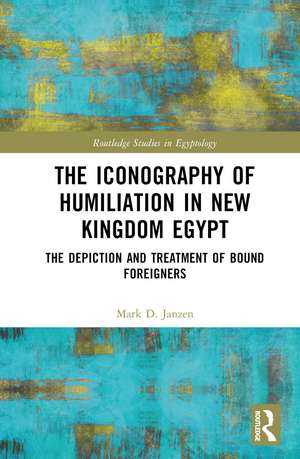The Iconography of Humiliation in New Kingdom Egypt: The Depiction and Treatment of Bound Foreigners: Routledge Studies in Egyptology
Autor Mark D. Janzenen Limba Engleză Hardback – 26 noi 2024
Depictions of foreign captives in humiliating or torturous poses are ubiquitous in Egyptian iconography and reflect the celebratory nature of royal ideology, in this case by degrading enemies. Egyptologists have scrutinized these scenes for details regarding various military matters, but existing scholarly literature offers few studies focused on enemy captives and the sheer physical brutality of the depictions of their bindings. Janzen examines the bound foreigner motif in New Kingdom sources, demonstrating that these prisoners of war played vital roles in Egyptian ideology and religion. Their depictions in bizarre or torturous poses served to reinforce ideological underpinnings of pharaoh’s right to rule, perpetually ritualizing their defeat and/or punishment through the presence of this iconography on ceremonial objects used primarily by the king and on temple walls and monuments. The subjugation of foreigners also constituted an important economic function, as incorporating prisoners of war into the Egyptian workforce was crucial for economic prosperity and growth in New Kingdom Egypt. The volume also explores cross-cultural and anthropological parallels, placing Egyptian treatment of foreign prisoners in its ancient context.
The book provides a fascinating study of the subject suitable for scholars and students of Egyptology and ancient history, particularly that of New Kingdom Egypt, as well as those working on power, warfare, and violence in the ancient world more broadly.
Preț: 934.96 lei
Preț vechi: 1027.43 lei
-9% Nou
Puncte Express: 1402
Preț estimativ în valută:
178.91€ • 188.13$ • 147.83£
178.91€ • 188.13$ • 147.83£
Carte tipărită la comandă
Livrare economică 17 aprilie-01 mai
Preluare comenzi: 021 569.72.76
Specificații
ISBN-13: 9781032492919
ISBN-10: 1032492910
Pagini: 320
Ilustrații: 182
Dimensiuni: 156 x 234 x 21 mm
Greutate: 0.45 kg
Ediția:1
Editura: Taylor & Francis
Colecția Routledge
Seria Routledge Studies in Egyptology
Locul publicării:Oxford, United Kingdom
ISBN-10: 1032492910
Pagini: 320
Ilustrații: 182
Dimensiuni: 156 x 234 x 21 mm
Greutate: 0.45 kg
Ediția:1
Editura: Taylor & Francis
Colecția Routledge
Seria Routledge Studies in Egyptology
Locul publicării:Oxford, United Kingdom
Public țintă
Postgraduate and Undergraduate AdvancedCuprins
1. Introducing the Iconography and its Discontents; 2. Ideology, Politics, and Propaganda: The Role of Foreigners in Royal Legitimization; 3. The Ubiquity of the Motif: Rhetorical Depictions of Artifacts from the Tomb of Tutankhamun and Related Objects; 4. The Creativity of the Motif: Interactive Depictions; 5. Bound Foreigners in 18th Dynasty Reliefs; 6. Bound Foreigners in the Battle Reliefs of Seti I and Ramesses II; 7. Chasing Greatness: Bound Foreigners in the Reliefs of Merneptah and Ramesses III; 8. The Textual Record and the Fate of Prisoners of War; 9. Cross-Cultural Parallels and Modern Sensibilities; Conclusion.
Recenzii
“Mark D. Janzen has written the most welcomed first monographic study on the bound prisoner motif in New Kingdom Egyptian art. He goes beyond mere descriptive account of the available evidence by seriously taking into account the corporeality of binding. Janzen considers the painful experiences binding must have caused to Egyptian enemies and urges us to see the images of bound foreigners in a new light.” - Uroš Matić, Austrian Archaeological Institute, Austrian Academy of Sciences
Notă biografică
Mark D. Janzen is Associate Professor of Archaeology and Ancient History at Lipscomb University. He received his PhD from the University of Memphis (ancient history). His primary research interests are Egyptian epigraphy and archaeology, New Kingdom military history, and the Israelite exodus.
Descriere
This volume analyzes the iconography of bound foreigners on New Kingdom monuments and artifacts in order to better understand Egyptian perspectives on foreigners and their treatment of prisoners of war.





